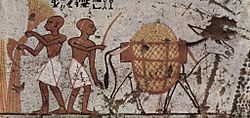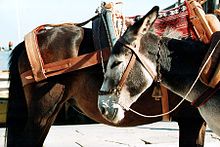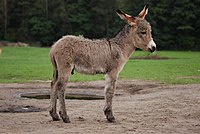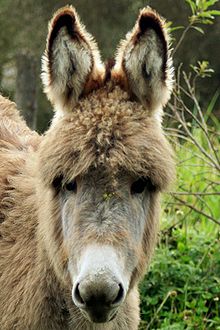A male donkey or ass is called a jack, a female a jenny, and an offspring less than one year old a foal (male: colt, female: filly).
While different species of the Equidae family can interbreed, offspring are almost always sterile. Nonetheless, horse/donkey hybrids are popular for their durability and vigor. A mule is the offspring of a jack (male donkey) and a mare (female horse). The much rarer successful mating of a male horse and a female donkey produces a hinny.
Asses were first domesticated around 3000 BC,[3] approximately the same time as the horse, and have spread around the world. They continue to fill important roles in many places today and domesticated species are increasing in numbers, but the African wild ass and another relative, the Onager, are endangered. As "beasts of burden" and companions, asses and donkeys have worked together with humans for millennia.
Breeding
Jennies are normally pregnant for about 12 months, though the gestation period varies from 11 to almost 14 months.[4] Jennies usually give birth to a single foal. Twins are very rare: only about 1.7 percent of donkey pregnancies result in twins, and both twins survive in only about 14 percent of cases.[citation needed]Characteristics
Domestic donkeys vary considerably in size, depending on breed and management. The height at the withers ranges from 80 to 160 cm (31 to 63 in), and the weight from 80 to 480 kg (176 to 1,058 lb). Donkeys have a lifespan of 30 to 50 years.[5]Donkeys are adapted to marginal desert lands, and have many traits that are unique to the species as a result. Wild donkeys live separated from each other, unlike tight wild horse and feral horse herds. Donkeys have developed very loud vocalizations, which help keep in contact with other donkeys over the wide spaces of the desert. The best-known call is referred to as a "bray," which can be heard for over three kilometers. Donkeys have larger ears than horses. Their longer ears may pick up more distant sounds,[citation needed] and may help cool the donkey's blood. Donkeys in the wild can defend themselves with a powerful kick of their hind legs as well as by biting and striking with their front hooves.
Communication
Braying is the characteristic sound made by an ass, donkey, and most mules. Donkeys use this sound to communicate and will bray more frequently when a new donkey is encountered. The sound typically lasts for twenty seconds.[6][7] The sound may be rendered onomatapoeically as "eeyore" and so this was used as the name of the donkey in Winnie-the-Pooh. Donkeys may be trained to bray or not to bray upon command. This may be used as a form of mockery.[8][9] Braying may be considered a simile for loud and foolish speech. For example,[10]There are braying men in the world as well as braying asses; for what's loud and senseless talking and swearing, any other than braying
Nutrition
Donkeys' tough digestive system is somewhat less prone to colic than that of horses, can break down near-inedible vegetation and extract moisture from food very efficiently. As a rule, donkeys need smaller amounts of feed than horses of comparable height and weight. Because they are easy keepers, if overfed, donkeys are also quite susceptible to laminitis.Donkeys gain most of their daily energy needs from structural carbohydrates. An average, healthy donkey only requires free choice feeding of low-calorie fiber-rich forage such as straw (preferably barley straw), supplemented with controlled grazing in the summer and hay in the winter. A donkey’s requirement for protein and fat are so low that in practice once the energy requirements are met so too are the protein and fat requirements.[13] Cereal based feeds designed for horses are often too high in energy levels and will exceed the daily requirements of donkeys.[11] Even a small amount of grazing or fresh fodder during the spring and summer will provide adequate vitamin levels, so for a normal, healthy donkey a diet of straw plus a little grazing or hay meets their nutritional needs without need for concentrated feeds. A low-calorie vitamin and mineral supplement is recommended for donkeys year-round when on a restricted diet, and to all donkeys during the winter months.
Etymology of the name
Until recently the synonym ass was the more common term for Equus asinus (as in jackass, meaning "male donkey"). The first written use of donkey is as recent as 1785.[15] While the word ass has cognates in most other Indo-European languages, donkey is an etymologically obscure word for which no credible cognate has been identified. Hypotheses on its derivation include the following:- Perhaps a diminutive of dun (dull grayish-brown), a typical donkey colour.[15][16]
- Perhaps from the name Duncan.[15][17]
- Perhaps of imitative origin.[17]
Scientific name
Traditionally, the scientific name for the donkey is Equus asinus asinus based on the principle of priority used for scientific names of animals. However, the International Commission on Zoological Nomenclature has ruled in 2003 that if the domestic species and the wild species are considered subspecies of each other, the scientific name of the wild species has priority, even when that subspecies has been described after the domestic subspecies.[2] This means that the proper scientific name for the donkey is Equus africanus asinus when it is considered a subspecies, and Equus asinus when it is considered a species.History

Ancient Greek rhyton in the shape of a donkey's head, ca. 440 BC–430 BC, from Athens. Louvre Museum, Paris.
 Donkey in an Egyptian painting c. 1298-1235 BC |
For the Greeks, the donkey was associated with Dionysus, the god of wine. The Romans also valued the ass and would use it as a sacrificial animal[citation needed]
Equines had become extinct in the Western Hemisphere at the end of the last Ice Age. However, horses and donkeys were brought back to the Americas by the Conquistadors. In 1495,[citation needed]the ass first appeared in the New World when Christopher Columbus brought four jacks and two jennys. It is from this bloodline that many of the mules which the Conquistadors used while they explored the Americas were produced.[citation needed] Shortly after the United States became independent, President George Washington imported the first mammoth jack stock into the country. Because the existing Jack donkeys in the New World at the time lacked the size and strength he sought to produce quality work mules, he imported donkeys from Spain and France, some standing over 1.63 m tall. One of the donkeys Washington received from the Marquis de Lafayette, named "Knight of Malta", stood 1.43 m and thus was regarded as a great disappointment. Viewing this donkey as unfit for producing mules, Washington instead bred Knight of Malta to his jennys and, in doing so, created an American line of Mammoth Jacks (a breed name that includes both males and females).
Despite these early appearances of donkeys in America, the donkey did not find widespread distribution in America until it was found useful as a pack animal by miners, particularly the gold prospectors, of the mid-19th century. Miners preferred this animal due to its ability to carry tools, supplies, and ore. Their sociable disposition and adaptation to human companionship allowed many miners to lead their donkeys without ropes. They simply followed behind their owner. As mining became less an occupation of the individual prospector and more of an industrial underground operation, the miners' donkeys lost their jobs, and many were simply turned loose into the American deserts. Descendants of these donkeys, now feral, can still be seen roaming the Southwest today.
By the early 20th century, donkeys began to be used less as working animals and instead kept as pets in the United States and other wealthier nations, while remaining an important work animal in many poorer regions. The increased popularity of the donkey as a pet in the USA was seen in the appearance of the miniature donkey in 1929. Robert Green imported miniature donkeys to the United States and was a lifetime advocate of the breed and said of it, "Miniature donkeys possess the affectionate nature of a Newfoundland, the resignation of a cow, the durability of a mule, the courage of a tiger, and the intellectual capability only slightly inferior to man's."
Although the donkey faded from public notice and became viewed as a comical, stubborn beast which was considered "cute" at best, the donkey has recently regained some popularity in North America as a mount, for pulling wagons, and even as a guard animal. Some standard species are ideal for guarding herds of sheep against predators, since most donkeys have a natural wariness toward coyotes and other canines, and will keep them away from the herd.
Economic use

On the island of Hydra, because cars are outlawed, donkeys and mules form virtually the sole method of heavy goods transport.
 Classic British seaside donkeys in Skegness |
A few donkeys are milked or raised for meat;[21] in Italy, which has the highest consumption of equine meat in Europe and where donkey meat is the main ingredient of several regional dishes, only about 1000 donkeys were slaughtered in 2010, yielding approximately 100 tonnes of meat.[22] Asses' milk may command good prices: the average price in Italy in 2009 was €15 per litre,[23] and a price of €6 per 100 ml was reported from Croatia in 2008; it is used for soaps and cosmetics as well as dietary purposes. The niche markets for both milk and meat are expanding.[20]
Donkeys have a notorious reputation for stubbornness, but this has been attributed to a much stronger sense of "self preservation" than exhibited by horses.[24] Likely based on a stronger prey instinct and a weaker connection with man, it is considerably more difficult to force or frighten a donkey into doing something it perceives to be dangerous for whatever reason.
Once a person has earned their confidence they can be willing and companionable partners and very dependable in work[citation needed]. For this reason, they are now commonly[citation needed] kept as pets in countries where their use as beasts of burden has disappeared. Donkey rides for children are also a popular[citation needed] pastime for children in holiday resorts or other leisure contexts.
Shoeing
 A donkey shoe with calkins |
 Farriers shoeing a donkey in Cyprus in 1900 |
Donkeys in warfare
Donkeys have been used throughout history for transportation of supplies, pulling wagons, and, in a few cases, as riding animals. During World War I a British stretcher bearer, John Simpson Kirkpatrick, serving with the Australian and New Zealand Army Corps, used a donkey named Duffy to rescue wounded soldiers, carrying them to safety in Gallipoli. There is a statue of John Simpson Kirkpatrick and his donkey in his home town, South Shields.According to British food writer Matthew Fort, donkeys were, until recently, used in the Italian Army. The Mountain Fusiliers each had a donkey to carry their gear, and in extreme circumstances the animal could be eaten.[26] In 2006, security forces in Afghanistan prevented a man from entering a town in Zabul Province with a donkey which he had laden with 30 kg (66 lbs.) of explosives and a number of landmines, which the man had planned to set off with a remote controlled detonator.[27]
Present status
About 41 million donkeys were reported worldwide in 2006.[20] China has the most with 11 million, followed by Pakistan, Ethiopia and Mexico. Some researchers believe the actual number is somewhat higher since many donkeys go uncounted.[21] The number of breeds and percentage of world population for each of the FAO's world regions was in 2006:[20]| Region | No. of breeds | % of world pop. |
|---|---|---|
| Africa | 26 | 26.9 |
| Asia & Pacific | 32 | 37.6 |
| Europe & the Caucasus | 51 | 3.7 |
| Latin America & the Carribean | 24 | 19.9 |
| Near & Middle East | 47 | 11.8 |
| North America | 5 | 0.1 |
| World | 185 | 41 million head |
The Domestic Animal Diversity Information System (DAD-IS) of the FAO listed 189 breeds of ass in June 2011.[29] In 2000 the number of breeds of donkey recorded worldwide was 97, and in 1995 it was 77. The rapid increase is attributed to attention paid to identification and recognition of donkey breeds by the FAO's Animal Genetic Resources project.[20].
See also: List of donkey breeds
In prosperous countries, the welfare of donkeys both at home and abroad has recently become a concern, and a number of sanctuaries for retired and rescued donkeys have been set up. The largest is the Donkey Sanctuary of England, which also supports donkey welfare projects in Egypt, Ethiopia, India, Kenya, and Mexico.[30]Feral donkeys and wild asses
In some areas domestic donkeys have returned to the wild and established feral populations, such as the Burro of North America and the Asinara donkey of Sardinia, Italy, both of which have protected status. Feral donkeys can also cause problems, notably in environments that have been evolutionarily free of any form of equid, such as Hawaii.[31]Wild asses, onagers, and kiangs
With domestication of almost all donkeys few species now exist in the wild. They include the African Wild Ass, Equus africanus, and its critically endangered subspecies the Somali Wild Ass, Equus africanus somaliensis, and Nubian Wild Ass, Equus africanus africanus, the principal ancestor of the domestic donkey.[20] Extinct species include the European Ass, Equus hydruntinus, which became extinct during the Neolithic, and the North African Wild Ass, Equus africanus atlanticus, which became extinct in Roman times.[20]There are also five subspecies of Asiatic Wild Ass or Onager, Equus hemionus, and three subspecies of the kiang, Equus kiang, of the Himalayan upland.
In the wild asses can reach top speeds equalling zebras and even most horses.
Donkey hybrids
A male donkey (jack) can be crossed with a female horse to produce a mule. A male horse can be crossed with a female donkey (jennet or jenny) to produce a hinny. A female donkey in the UK is called a mare, or jenny.Horse-donkey hybrids are almost always sterile because horses have 64 chromosomes whereas donkeys have 62, producing offspring with 63 chromosomes. Mules are much more common than hinnies. This is believed to be caused by two factors, the first being proven in cat hybrids, that when the chromosome count of the male is the higher, fertility rates drop (as in the case of stallion x jennet).[citation needed] The lower progesterone production of the jenny may also lead to early embryonic loss. In addition, there are reasons not directly related to reproductive biology. Due to different mating behavior, jacks are often more willing to cover mares than stallions are to breed jennys. Further, mares are usually larger than jennys and thus have more room for the ensuing foal to grow in the womb, resulting in a larger animal at birth. It is commonly believed that mules are more easily handled and also physically stronger than hinnies, making them more desirable for breeders to produce, and it is unquestioned that mules are more common in total number[citation needed].
The offspring of a zebra-donkey cross is called a zonkey, zebroid, zebrass, or zedonk;[32] zebra mule is an older term, but still used in some regions today. The foregoing terms generally refer to hybrids produced by breeding a male zebra to a female donkey. Zebra hinny, zebret and zebrinny all refer to the cross of a female zebra with a male donkey. Zebrinnies are rarer than zedonkies because female zebras in captivity are most valuable when used to produce full-blooded zebras.[33] There are not enough female zebras breeding in captivity to spare them for hybridizing; there is no such limitation on the number of female donkeys breeding.
Cultural references
| This "In popular culture" section may contain minor or trivial references. Please reorganize this content to explain the subject's impact on popular culture rather than simply listing appearances, and remove trivial references. (September 2010) |
- Buridan's ass is an illustration of a paradox in philosophy in the conception of free will.
Religion and myth
- There are 68 references to a donkey ("hamor" or "chamor" חמור) in the Old Testament, starting with a gift of some to Abraham by the Pharaoh in Genesis 12:16. A donkey features in the binding of Isaac (Genesis 22:3). Donkeys are again mentioned as a measure of wealth in the story of Jacob's life in Genesis 30:43.
- In Genesis the King of Shechem (the modern Nablus), killed by Jacob's sons, is called "Hamor" - showing that at the time this animal was held in high enough esteem that it was no disrespect for royalty to use its name as their first name. (See Dinah, Shechem, Animal names as first names in Hebrew.)
- In Numbers 22:22-41 "The Lord opened the mouth of the donkey" (vs. 28) and it speaks to Balaam. In Judges 15:13-17 where the hero Samson slays Philistines with the jawbone of an ass. Additional references can be found in Deuteronomy 22:10, Job 11:12, Proverbs 26:3 and elsewhere.
- In Jewish Oral Tradition, the son of David was prophesied as riding on a donkey if the tribes of Israel are undeserving of redemption.[34] As noted, in the context of the Torah this connoted wealth and affluence befitting the House of David, as at the time commoners are described as simply going on foot.
- The donkey mostly appears reflecting the natural environment and as an aspect of an agricultural economy. The Bible often specifies whether a person rode donkeys, since this was used to indicate a person’s wealth in much the same way luxury cars do today. (Horses at that time were used solely for war, powerful kings such as Solomon being the only ones who could afford to import them from Egypt.)
- In contemporary Israel, the term "Messiah's Donkey" (Chamoro Shel Mashiach חמורו של משיח) stands at the center of a controversial religious-political doctrine, attributed to Rabbi Avraham Yitchak Hacohen Cook, under which it was the Heavenly-imposed "task" of secular Zionists to build up a Jewish State, but once the state is established they are fated to give place to the Religious who are ordained to lead the state. The secularists in this analogy are "The Donkey" while the religious who are fated to supplant them are a collective "Messiach". A book on the subject, published in 1998 by the militant secularist Sefi Rechlevsky, aroused a major controversy in the Israeli public opinion.[35]
- Greek mythology includes the story of King Midas who judged against Apollo in favor of Pan during a musical contest, and had his ears changed to those of a donkey as punishment.
- The ass was a symbol of the Greek god Dionysus, particularly in relationship to his companion, Silenus.
- The most common Greek word for ass appears roughly 100 times in the Biblical text. In the Gospels, Jesus rides a donkey into Jerusalem (Mark 11:1 in which colt refers to a donkey colt).
- Traditionally, Mary is portrayed as riding a donkey while pregnant. Legend has it that the cross on the donkey’s shoulders comes from the shadow of Christ’s crucifixion, placing the donkey at the foot of the cross. It was once believed that hair cut from this cross and hung from a child’s neck in a bag would prevent fits and convulsions. However, in later times when the aristocracy used horses, depicting the Jesus as riding a donkey came to have an opposite connotation, as indicating a simple, sober way of life and avoiding luxury. The same connotation is evident in the description of saints such as Francis of Assisi as riding donkeys.
- Muhammad, the prophet of Islam said that dogs and donkeys, if they pass in front of men in prayer, will void or nullify that prayer.[36] He also said that "when you hear the braying of donkeys, seek Refuge with Allah from Satan for (their braying indicates) that they have seen a devil."[37]
- Several were buried in Hor-Aha's tomb
Fable and folklore
- European folklore claims that the tail of a donkey can be used to combat whooping cough or scorpion stings.
- In Panchatantra which is a collection of animal fables, where are two stories of donkey 1) The Lion and The Foolish Donkey and 2)The Singing Donkey
- In Hitopadesha there is a story of Donkey named The Donkey and the Dog
- One of Aesop's fables has an ass dressed in a lion skin who gives himself away by braying.
- La Fontaine's fable about the donkey of a miser who made the donkey work hard and eat less, coming to one day when thieves came and the donkey told his master to run for his life; however, the donkey didn't care about escaping, because one way or another he would continue working hard.
| Donkey | |
|---|---|
 | |
| Conservation status | |
Domesticated
| |
| Scientific classification | |
| Kingdom: | Animalia |
| Phylum: | Chordata |
| Class: | Mammalia |
| Order: | Perissodactyla |
| Family: | Equidae |
| Genus: | Equus |
| Subgenus: | Asinus |
| Species: | E. africanus |
| Subspecies: | E. africanus asinus |
| Trinomial name | |
| Equus africanus asinus Linnaeus, 1758 | |







No comments:
Post a Comment